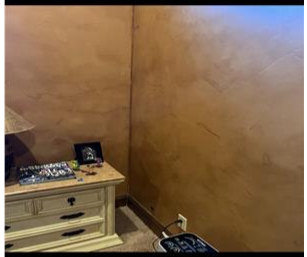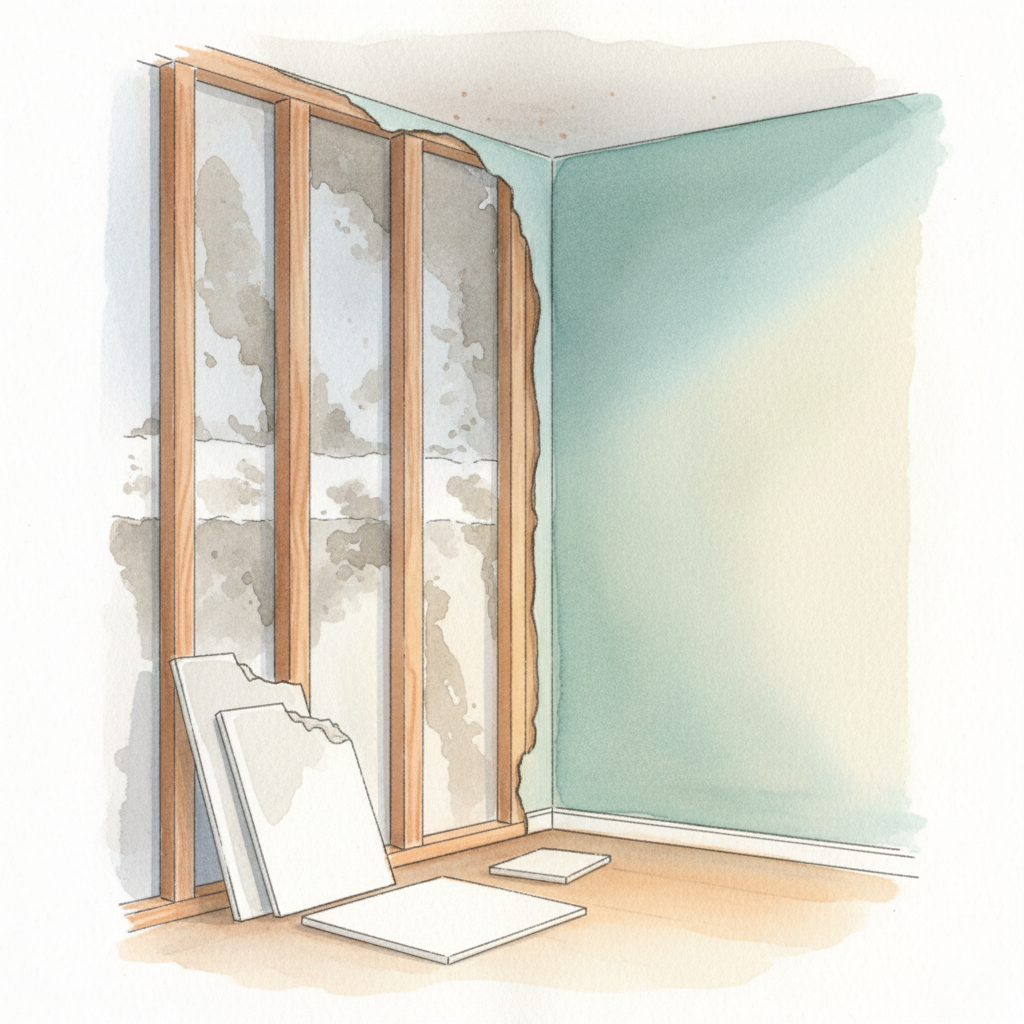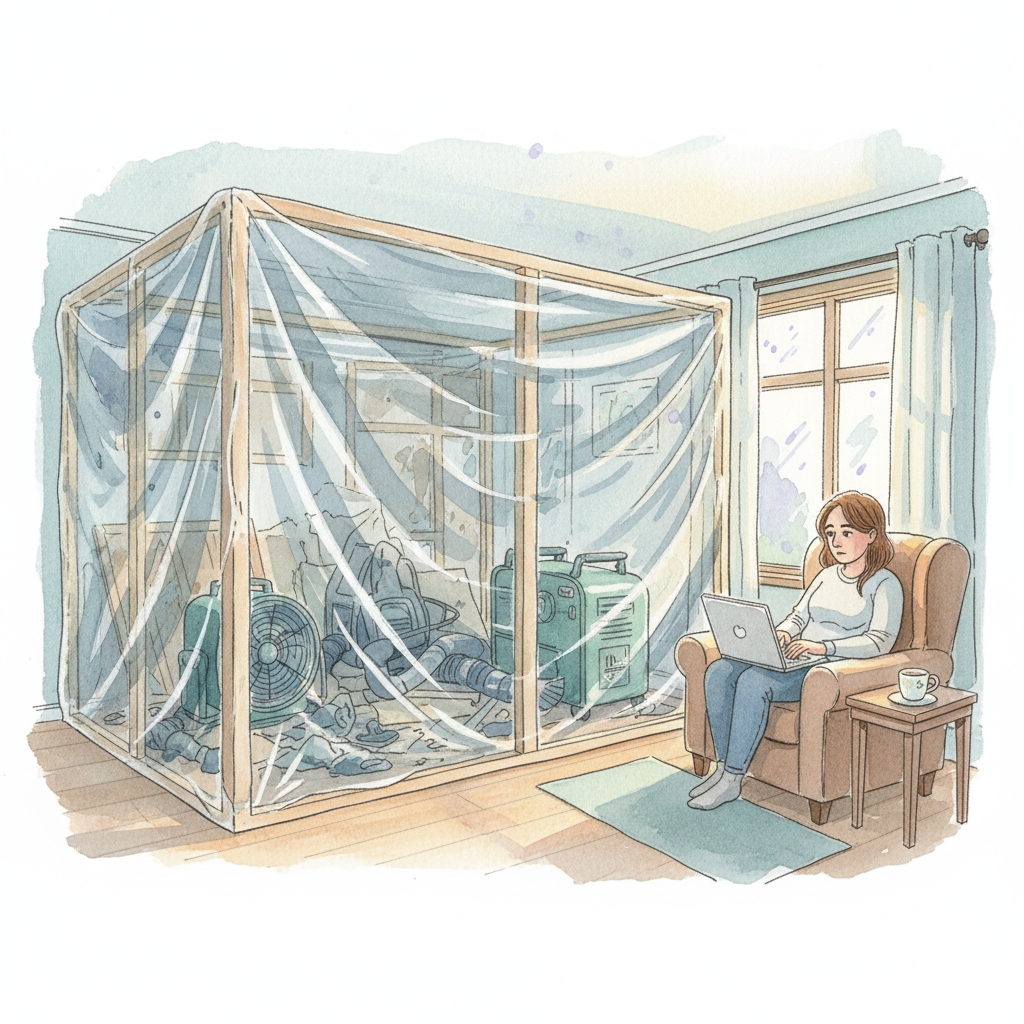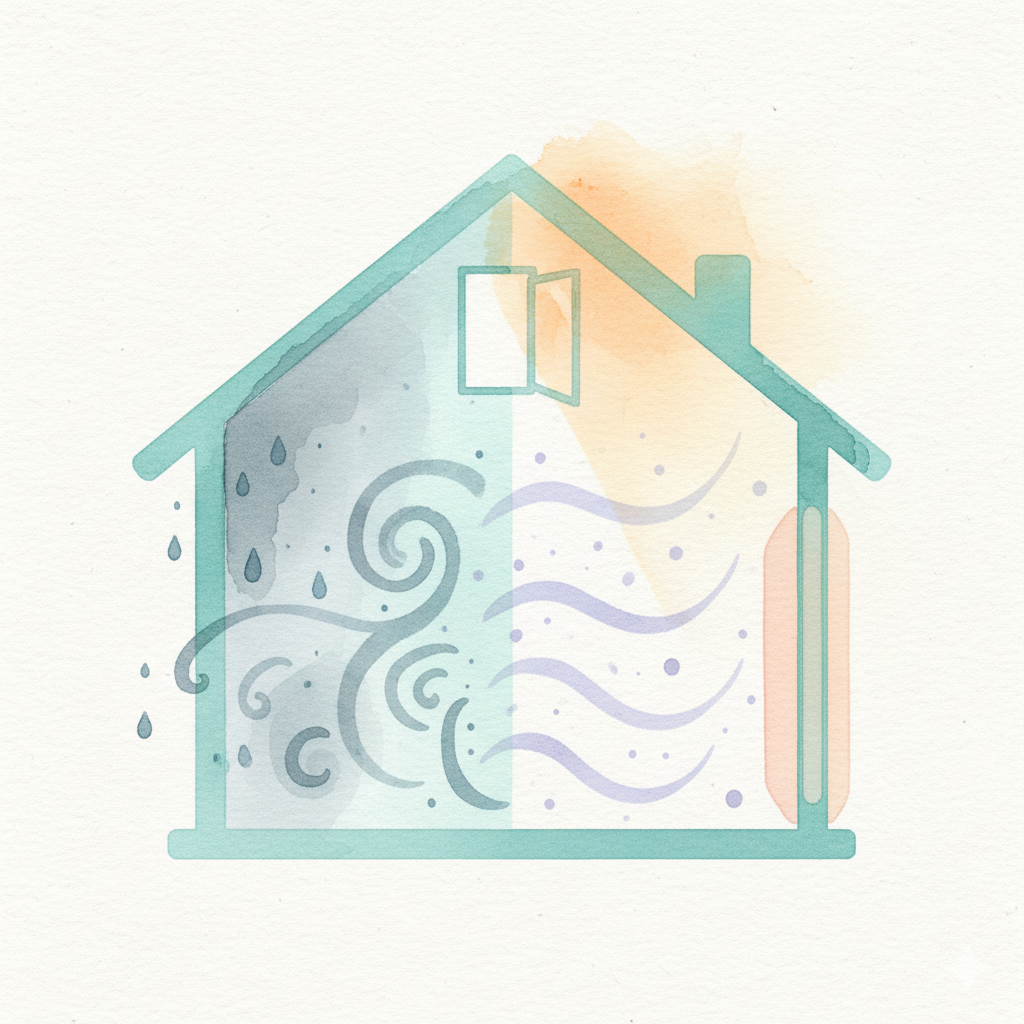
When Home Becomes the Hidden Enemy: My Journey from Mold Illness to Thriving Again
Your body is wise—we listen, simplify, and guide.
Part 1: When My Safe Haven Became My Silent Enemy - How I discovered hidden mold in my home
Part 2: When My Body Became a Stranger to Me - Understanding mold illness symptoms
Part 3: Tearing Down to Build Back Up - What real remediation looks like ← You are here
Part 4: From Surviving to Thriving - My recovery journey (November 17, 2025)
📖 Catching Up: What Happened in Parts 1 & 2
In Part 1, I shared how I discovered hidden mold throughout my home—behind shower tiles, in my garage refuge, beneath a balcony deck with no visible water damage. For nearly two decades, I'd been living in contamination while doctors treated my symptoms but never asked about my environment.
In Part 2, I walked you through the science of mold illness—how mycotoxins hijack your immune system, gut, brain, skin, and hormones all at once. I explained why standard allergy tests miss it, why it mimics so many other conditions, and how I finally confirmed through testing that mold was affecting my body at a cellular level.
Now in Part 3, let's talk about what comes next: the reality of professional mold remediation.
New to this series? Start with Part 1 to understand how hidden mold was discovered.
Tearing Down to Build Back Up
"I knew it wouldn't be pretty. I didn't know it would take six months.
After the professional inspection revealed contamination in over 20 areas of my home, I knew what was coming.
This wasn't going to be a simple fix. Walls would come down. Materials would be removed. My home would become a construction zone.
I went in with my eyes open—or so I thought.
What I didn't expect was just how long it would take. How many complications would arise. How emotionally exhausting it would be to watch my sanctuary systematically torn apart, even when I knew it was necessary.
And I definitely didn't expect the rebuild to be even more stressful than the remediation itself.
Here's what I learned about real mold remediation—and why knowing it won't be easy still doesn't prepare you for everything that comes.
The Moment I Knew DIY Wouldn't Work
Before I understood the scope of the problem, I tried to help myself.
I had my air ducts professionally cleaned, thinking that would eliminate whatever was circulating through my home.
Instead, it unleashed a dust explosion throughout the house.
Particles settled on everything—furniture, counters, bedding, clothes. My symptoms flared immediately and severely. I felt like I couldn't breathe in my own home.
A friend who came to help supervise remediation helped me vacuum everything. We ran HEPA filters constantly. I started bagging up items and getting rid of things, thinking contamination was on my belongings.
But the truth was more complicated than surface dust.
The mold wasn't just in my house—it was part of the structure itself. Behind walls. Inside materials. Growing where no vacuum could reach.


That's when I realized: this wasn't a cleaning problem. This was a construction problem.
Finding Someone Who Would Actually Do It Right
After the inspection revealed the full scope—over 20 contaminated areas documented in a 500+ page report—I started getting estimates.
I contacted four remediation companies and asked them to review everything. All the thermal imaging. All the moisture readings. Every area where contamination had been found.
Most of them didn't want to deal with the whole picture.
They'd flip through the report, identify a few obvious problems, and say something like, "We can handle the guest house shower and the garage ceiling. That should take care of it."
Should.
But the report didn't say "should." It showed contamination in the guest house shower and bedroom and living room. In the garage ceiling and walls. In multiple bathrooms. In attic spaces. Behind a balcony deck where water had been seeping for who knows how long.
One company wanted to address "the major ones" and see how I felt. Another suggested we "start small" and expand if needed. A third gave me a price that seemed too good to be true—because it was. They planned to treat surfaces by fogging, not remove contaminated materials.
Three of the four didn't mention IICRC S520 standards—the industry protocols for professional mold remediation.¹
One of them actually listened.
They reviewed the entire report. They asked about my symptoms—the crushing fatigue, the digestive chaos, the brain fog, the skin that wouldn't heal. They didn't dismiss my health concerns or suggest I was being dramatic.
And they explained something crucial: mold remediation isn't about cleaning harder. It's about removing contaminated materials entirely and rebuilding correctly.
This wasn't going to be quick. It wasn't going to be cheap. And it wasn't going to be easy to live through.
But it was going to be thorough.
That's what my health required.
What Professional Remediation Actually Means


Real mold remediation follows specific industry standards—IICRC S520.¹ These aren't suggestions. They're protocols developed to protect both the people doing the work and the people living in the space afterward.
Here's what that actually looks like:
Containment
Heavy plastic sheeting seals off work areas from the rest of the house. This isn't optional—it prevents spores from spreading to unaffected areas during demolition.² Your home starts looking like a crime scene, but that barrier is protecting you.
Negative Air Pressure
Special machines create airflow that pulls contaminated air into the work zone and filters it through HEPA systems before releasing it outside.² This ensures spores don't escape containment and resettle elsewhere.
Personal Protective Equipment
Professionals arrive in full respirators, protective suits, and gloves. They're treating your home like the contaminated environment it is—because it is.
Source Removal, Not Surface Treatment
This is the part most people don't understand: contaminated materials have to be removed, not cleaned.¹
Mold has root structures called hyphae that penetrate porous materials like drywall, wood, and insulation. You can kill what's visible on the surface, but the structure underneath remains compromised. The material itself has to go.
HEPA Filtration Throughout
Air scrubbers run continuously during the work. Every surface that can't be removed gets HEPA-vacuumed multiple times. The goal is capturing microscopic spores, not just visible dust.
Proper Disposal
Contaminated materials get double-bagged and disposed of according to regulations—not just tossed in your regular trash where they could expose waste workers or contaminate other areas.
This is why real remediation takes time. This is why it costs more than a cleaning service.
And this is why cutting corners doesn't work.
January 9, 2024: The Day I Signed
I signed the work authorization on January 9, 2024.
The scope was clear. The estimate was detailed. And I knew there was no turning back.
What I didn't know was how quickly "normal" would disappear.
In those first few days, I tried to stay ahead of the process. While they were setting up equipment and preparing to start, I was out shopping for replacement tile. I thought if I could get materials ordered early—have them ready the moment we got clearance—we could minimize downtime between remediation and reconstruction.
I was trying to control something. Anything.
It didn't quite work out that way.
The Drying Phase: Becoming a Refugee in My Own Home
By January 12th, the drying equipment arrived.
Industrial dehumidifiers. Air movers. Machines running 24/7, pulling moisture out of materials that had been harboring contamination for years.
The noise was constant. A low, mechanical hum that became the soundtrack of my life.
I was still living in the house—hiding in rooms that weren't under active work. Doors closed. Trying to create some pocket of normalcy while my home transformed into something I barely recognized.
"Hiding" is the right word. I wasn't living. I was surviving in the spaces they hadn't reached yet.
The drying phase lasted until January 17th. Five days that felt like weeks.
I kept thinking: "Once they dry it out, we can start fixing it."
But drying wasn't the start of remediation. It was just preparation for the real work ahead.
The Investigation Phase: Finding the Full Extent
From January 17th through the end of the month, they weren't demolishing yet. They were investigating.
Creating inspection holes. Opening walls carefully to see what was behind them. Using moisture meters and thermal imaging to map the contamination before they started removing materials.
This is the phase where the scope expands.
Each inspection hole revealed something new. Contamination spreading further than anyone expected. Moisture pathways connecting areas we thought were separate. Hidden damage that had been there for years.
I'd think we were almost ready to start remediation, and they'd say, "We need to create another inspection hole. We're finding more."
Every "more" felt like a gut punch.
But here's what I understand now: **finding it during investigation is better than sealing it back up and discovering it later.**
This phase is where professional remediation separates itself from DIY fixes. They weren't guessing. They were mapping the full extent before touching anything.
By the time January ended, we had the complete picture.
It was worse than I thought. But at least we finally knew what we were dealing with.
The Demolition Begins
Once the investigation phase was complete, the real work started.
I thought I understood what was coming. I'd seen the inspection report. I knew which areas were affected.
What I didn't expect was how much the scope would expand once they started opening walls.
The Guest House
What started as addressing the shower turned into multiple areas. The bathroom cleared first—that January 17th victory. But the bedroom was a separate issue: contamination from the balcony drain leak, moisture pathways spreading through walls. Once they opened areas up, the interconnected damage became clear.
The Garage
My refuge. The space where I spent time relaxing with the dogs, thinking I was safe. The ceiling came down first, revealing rotted deck sheeting above and warped trusses. The leak from the balcony had been worse than anyone realized. Walls followed.
The Bathrooms
Main house bathroom. Basement bathroom. Guest bathrooms. Each one revealing its own story of long-term moisture intrusion behind tiles, under vanities, inside walls where steam had been escaping for years.
The Attics
Master attic. Catwalk attic. Guest bedroom attic. Spaces I rarely entered but that had been quietly harboring contamination that affected the rooms below.
Then Came the Surprises
In May—May—they discovered the upstairs bedroom.
We thought we were nearly done. Final walk-throughs. Almost there.
Then during inspection they found it: pre-existing mold in the upstairs bedroom and bathroom. Mold that had been there since the house was built, hidden behind walls, completely unknown.
More demolition. More containment. More waiting.
And just when we thought *that* was handled, a plumber made a mistake in the guest house bedroom area—where the balcony drain had been causing issues. That required additional remediation work.
Every time I thought we were approaching the finish line, something new appeared.
Living in a Construction Zone
Six months.
That's how long my home was in an active remediation or a rebuild site.
People hear "six months" and think that's excessive. But when you're remediating over 20 areas across multiple structures, with proper containment protocols that prevent working on everything simultaneously, it's not slow—it's thorough.
What those six months actually looked like:
Plastic sheeting everywhere, turning my home into a maze of sealed-off zones. Rooms I couldn't access. Spaces I couldn't use.
The noise. Constant jackhammering. Pounding. Scraping. Industrial fans running 24/7. The hum became the soundtrack of my life.
I hid in the rooms that weren't under active work—doors closed, trying to create some normalcy while my house was systematically dismantled around me.
Insurance adjusters came through regularly, documenting everything, asking questions while I tried to maintain composure.
And the delays.
Late February to early March—nearly three weeks—waiting for approvals to proceed. The project paused while everyone reviewed the scope, inspected the damage, and decided what was covered.
Heavy rainstorms in March required emergency tarping and additional protection. Water is what caused this mess in the first place—we couldn't let more in while trying to fix it.
Each phase of clearance testing before moving to the next area. Waiting for results. Hoping each space would pass so we could move forward.
Oh boy, was I mad.
I sent emails that probably weren't professional. Text messages that definitely weren't patient. This wasn't just inconvenient—it was emotionally exhausting.
Watching the place that was supposed to be my sanctuary torn apart, knowing it was necessary but hating every minute of it.
When Everything That Can Go Wrong, Does
Remember how I was out buying replacement tiles in those first few days, trying to stay ahead of the process?
The wrong tile was ordered.
I don't even remember how we discovered it. But somewhere in the chaos of demolition and decisions and contractor communication, the tile I'd carefully selected didn't match what arrived.
More delays. More waiting for the right materials while work stalled.
Then came the insulation disaster.
We'd scheduled new insulation to be installed in the master attic as soon as remediation was complete. They were working through the attic access—thankfully, no holes cut in my bedroom ceiling—removing the contaminated insulation that had been harboring mold for years.
They got about halfway through when we learned the replacement insulation was backordered.
So there I was: master attic half-gutted, the thermal barrier between my bedroom and the Vegas heat significantly compromised. And March was experiencing record temperatures for that time of year.
My bedroom became unbearable.
The attic was in containment. Materials exposed. Work in progress. And we couldn't just "come back to it later"—the space had to be finished properly before moving to the next phase.
But without insulation? I was trying to sleep in a house that had lost half its protection from the heat.
These weren't catastrophic failures. They were the cascading complications that happen when you're coordinating materials, weather, contractors, and real life.
Each one added time. Each one added frustration. Each one reminded me that I couldn't control any of this.
I could only endure it.
The First Victory: January 17, 2024
Less than a month after signing the contract, I got the news: the guest house bathroom had passed clearance testing.
After weeks of noise, demolition, containment barriers, and living in construction chaos, I finally had proof that this process actually worked.
That first passing test mattered more than I expected.
It meant the protocols were sound. The remediation company knew what they were doing. The money, disruption, and emotional exhaustion weren't for nothing.
We still had months of work ahead—the garage, more bathrooms, the attics, areas we hadn't even discovered yet. But January 17th gave me something I desperately needed: evidence that we were moving in the right direction.
The spaces they remediated were actually becoming safe.
The Turning Point: When I Knew It Was Working
Sometime during those six months, something happened that gave me hope.
I put on a sweatshirt I'd worn before remediation started—something that had been exposed to the contaminated environment.
Within hours, I felt it. The familiar symptoms are creeping back. Brain fog. Fatigue. That feeling of inflammation spreading through my body.
But here's what was different: I caught it quickly. And I controlled it.
I took the sweatshirt off, showered, and changed into clean clothes. And the symptoms subsided within a day.
Before remediation, I would have spiraled into a week-long flare. My body would have stayed in that inflammatory state, compounding and worsening.
This time, it didn't.
That's when I realized: the house wasn't holding onto it anymore.
The air wasn't continuously re-exposing me. My baseline inflammation had dropped enough that a single acute exposure didn't completely derail me.
For the first time in months—maybe years—I had evidence that my body could actually recover when the constant toxic exposure stopped.
That sweatshirt incident was awful. And it was also the most hope I'd felt in a long time.
Proof It Actually Worked: Clearance Testing
In mold remediation, you don't just guess when it's done. You test.
Post-remediation verification (PRV) is the final—and most critical—step.³ An independent certified mold assessor comes in after all the work is complete to verify that the space is actually safe.
They conduct visual inspections using specialized equipment, looking for any remaining signs of contamination or moisture. They test surfaces to ensure nothing reacts to hydrogen peroxide solutions (which would indicate organic growth). And they collect air samples both inside the remediated areas and outside as a control.
The standard: Indoor air quality must be equal to or better than outdoor air. No water-indicator mold types can be present indoors that aren't also in the outdoor control sample. Even one spore of certain types can cause a failure.
It's strict. It's scientific. And it's the only way to know for sure.
My clearance testing timeline:
January 17, 2024 — The guest house bathroom passed. The first space to clear. That moment—receiving the first passing test after weeks of demolition and doubt—felt like proof that this nightmare would actually end.
March 31, 2024 — The guest house bedroom passed. This was a separate area affected by the balcony drain leak—the same area where the plumber's mistake later required additional remediation work.
April 1, 2024 — The garage passed clearance. Another major space reclaimed.
April 12, 2024 — More areas passed verification.
May 15, 2024 — The upstairs bedroom and bathroom—the final discoveries—passed clearance testing.
Each passing test felt like reclaiming a piece of my home. Each one meant that space was no longer poisoning me
What Actually Changed: The Details That Mattered
People ask what makes remediation different from just "fixing it yourself."
Here's what actually happened in my home:
What Came Out:
-
Entire shower surrounds and tile systems—not just regrouting, complete removal
-
Contaminated drywall in multiple rooms
-
Bathroom vanities pulled completely out
-
Rotted deck sheeting and framing that had been hidden above the garage
-
Insulation that had been harboring mold for years
-
Door tracks, baseboards, anything porous that couldn't be adequately decontaminated
What Went In:
-
Proper moisture barriers where they should have been from the beginning⁴
-
New drywall installed to code
-
Fresh insulation
-
Correctly waterproofed shower systems
-
Treated and sealed framing
-
Antimicrobial coatings on surfaces that couldn't be removed
But beyond materials, here's what really changed: **the moisture pathways that had been feeding the mold were eliminated.**⁴
The balcony decks were properly rebuilt and sealed. The shower systems were rebuilt with correct waterproofing. The plumbing leaks were fixed. The steam escape routes were addressed.
Remediation wasn't just removing mold—it was removing the conditions that allowed mold to grow in the first place.
Recovery Begins: What Healed and When
At some point, I noticed something: my skin healed.
The constant itching stopped. The rashes that had been plaguing me for years just... cleared. My body was no longer desperately trying to eliminate toxins through my skin because the exposure had stopped.
That was the first tangible proof my body had been reacting to real environmental contamination—not some vague sensitivity or psychosomatic issue.
But my gut took longer.
The digestive chaos didn't resolve overnight. My gut lining had been damaged by years of mycotoxin exposure, increased intestinal permeability, and immune system dysregulation. That doesn't heal in days or even weeks.
The immediate inflammatory load was gone, yes. But the repair work my body needed to do? That took months of intentional support—the work I'll share in Part 4.
The most valuable thing I gained: awareness.
Now when symptoms flare, I can investigate my environment. I've learned to recognize mold exposure almost immediately.
That irritability that used to confuse me? That feeling of suddenly being "off" for no clear reason? Now I know: I'm not cranky. I'm exposed.
That awareness is a superpower I didn't have before.
Lessons I Learned the Hard Way
Some wisdom I earned through six months of demolition:
Moisture is the real enemy. Mold is just the symptom.⁴,⁵ Every tiny leak, crack, hidden drip, or condensation problem had to be found and fixed permanently. Otherwise you're just waiting for it to come back.
Cutting corners costs more. Those companies that wanted to "just handle the major areas"? If I'd listened to them, I'd be doing this again in a year. Surface treatments, antimicrobial sprays, bleach—none of it works if you don't remove contaminated materials and fix the moisture source.
Hire true specialists. General contractors aren't enough. Mold remediation is its own science with specific protocols. IICRC certification matters.¹ Post-remediation verification matters. Don't skip these steps.
Trust the process when discoveries expand the scope. I was furious every time they found something new. But each discovery was protecting my health. Better to find it now than to seal it back up and let it continue poisoning me.
Your body knows before the tests do. When I wore that contaminated sweatshirt and felt symptoms return—then watched them resolve quickly—that told me more than any air sample. My body had become the most sensitive detector I had.
**Nothing will go exactly as planned.** Wrong tile. Backordered materials. Record heat. Rainstorms. Delays for approvals. Unexpected discoveries. Budget for time, budget for complications, and budget for your own emotional resilience.
The Investment No One Talks About
I'm not going to pretend this was cheap.
Professional mold remediation following proper protocols, across multiple structures, with independent testing and proper reconstruction—it's expensive.
Insurance covered some of the initial water damage repairs. But the comprehensive remediation I needed? Most of that came out of pocket.
Was it worth it?
Ask me that question while I was writing angry emails in month four, and I might have had a different answer.
Ask me now, with my skin healed, my gut recovering, and the ability to finally sleep in my own bedroom without waking up inflamed?
Absolutely.
You can't put a price on getting your health back.
Some things you can't afford not to do.
What This Created: A Foundation for Healing
Remediation didn't heal me.
Let me be clear about that.
Remediation removed the constant toxic exposure that was preventing me from healing.
My body was still holding mycotoxins. My gut was still damaged. My detoxification pathways were still overwhelmed. My immune system was still dysregulated.
But for the first time in nearly two decades, I wasn't being re-exposed every single day.
That created space for the real healing work to begin.
The food strategies. The gentle detox support. The gut repair protocols. The nervous system regulation. All the things I'll share in Part 4.
None of that would have worked if I was still sleeping in a contaminated bedroom and relaxing in a contaminated garage.
Remediation wasn't the cure. It was the foundation.
Your Environment Shapes Your Health
If you're struggling with unexplained symptoms and you've tried everything—every diet, every supplement, every specialist—but you haven't investigated your environment, that's the missing piece.
Your body can't heal in the same environment that made it sick.²,⁶
Professional mold remediation isn't dramatic. It's not overreacting. It's not excessive.
It's respecting that your health is being shaped by everything surrounding you, and sometimes the only answer is removing what's harming you—completely.
Your home should support your healing, not silently steal it.
Ready to Investigate What's Been Overlooked?
If you suspect environmental factors might be affecting your health, you don't have to figure this out alone.
In our discovery call, we'll:
-
Discuss your symptom patterns and health history
-
Explore whether environmental factors could be involved
-
Identify what professionals you might need (inspection, testing, remediation)
-
Create a clear next step for investigation and support
I provide nutritional coaching and lifestyle support—I don't diagnose medical conditions or perform remediation. But I help you investigate the whole picture and connect with the right professionals when needed.
It's your body; I'm just helping to shine a light. 🔦
[Schedule Your Discovery Call →]
P.S. Take my free quiz: "Is Your Home Making You Sick?" Get personalized insights about potential environmental triggers and what to investigate next.
[Take the Quiz →]
🌿 Coming Up Next: Part 4
From Surviving to Thriving—My Recovery Journey
Remediation created the foundation, but my body still needed help healing from years of toxic burden.
In Part 4, I'll share the recovery strategies that actually worked:
-
Supporting detoxification without overwhelming an already stressed system
-
Healing gut damage and reducing inflammation
-
Rebuilding energy and reclaiming my life
-
The difference between surviving and truly thriving
Stay tuned for the final piece of this journey.
🌿 When Home Becomes the Hidden Enemy: My Journey from Mold Illness to Thriving Again
Your body is wise—we listen, simplify, and guide.
Part 1: When My Safe Haven Became My Silent Enemy - How I discovered hidden mold in my home
Part 2: When My Body Became a Stranger to Me - Understanding mold illness symptoms
Part 3: Tearing Down to Build Back Up - What real remediation looks like ← You just read this
Part 4: From Surviving to Thriving - My recovery journey (November 17)
References
- Institute of Inspection, Cleaning and Restoration Certification. ANSI/IICRC S520 Standard for Professional Mold Remediation. 4th ed. Institute of Inspection, Cleaning and Restoration Certification; 2024.
- Institute of Medicine. Damp Indoor Spaces and Health. Washington, DC: National Academies Press; 2004. Available from: https://www.ncbi.nlm.nih.gov/books/NBK215643/
- Mendell MJ, Mirer AG, Cheung K, Tong M, Douwes J. Respiratory and allergic health effects of dampness, mold, and dampness-related agents: a review of the epidemiologic evidence. Environ Health Perspect. 2011;119(6):748-756. Available from: https://www.ncbi.nlm.nih.gov/pmc/articles/PMC3114807/
- Trechsel HR, Bomberg MT, eds. Moisture Control in Buildings: The Key Factor in Mold Prevention. 2nd ed. West Conshohocken, PA: ASTM International; 2009.
- Rose WB. Moisture in buildings. In: Trechsel HR, Bomberg MT, eds. Moisture Control in Buildings: The Key Factor in Mold Prevention. 2nd ed. West Conshohocken, PA: ASTM International; 2009:231-248.
- Kercsmar CM, Dearborn DG, Schluchter M, et al. Reduction in asthma morbidity in children as a result of home remediation aimed at moisture sources. Environ Health Perspect. 2006;114(10):1574-1580. Available from: https://www.ncbi.nlm.nih.gov/pmc/articles/PMC1626393/
- World Health Organization. WHO Guidelines for Indoor Air Quality: Dampness and Mould. Geneva: WHO Regional Office for Europe; 2009. Available from: https://www.ncbi.nlm.nih.gov/books/NBK143941/






Comments